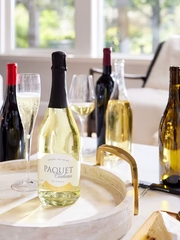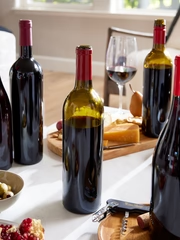 As the climate warms, winemakers and grape growers are changing the direction they grow vines, picking earlier, covering crops with shade cloth, and adapting in other ways. Others have invested in solar panels, electric vehicles, and climate action plans. Many now see a shift to dry farming has a perfect reaction to those problems.
Rethinking growing practices is critical because back-to-back dry years are more frequent. Since 2016, every year is warm and dry. The notion of vintages similar to those in Europe has been lost. Only the proximity to the ocean and the soil remains the main driver to define a particular Terroir.
A study released this summer by UC Davis viticulture department, found that California's wine industry is "not at a tipping point" because of climate change or its effects. Heatwaves and fires can have an immediate impact on winemaking but be assured that grapevines are not going to die. They might not be economical to grow for one or two years, but they always come back. There are very resilient plants.
Since the 1980s the climate has warmed steadily in California, which is not a bad thing for the industry to establish the state as a premier wine-growing region globally. This UC Davis viticulture study found growers can use half of the water they normally use without compromising the taste or color of wine. We started harvesting sweeter grapes, riper grapes, and the wine ratings have steadily increased. In short, quality has improved over time. Despite the negative impacts of climate change, the state’s $40 billion wine market is strong.
As the climate warms, winemakers and grape growers are changing the direction they grow vines, picking earlier, covering crops with shade cloth, and adapting in other ways. Others have invested in solar panels, electric vehicles, and climate action plans. Many now see a shift to dry farming has a perfect reaction to those problems.
Rethinking growing practices is critical because back-to-back dry years are more frequent. Since 2016, every year is warm and dry. The notion of vintages similar to those in Europe has been lost. Only the proximity to the ocean and the soil remains the main driver to define a particular Terroir.
A study released this summer by UC Davis viticulture department, found that California's wine industry is "not at a tipping point" because of climate change or its effects. Heatwaves and fires can have an immediate impact on winemaking but be assured that grapevines are not going to die. They might not be economical to grow for one or two years, but they always come back. There are very resilient plants.
Since the 1980s the climate has warmed steadily in California, which is not a bad thing for the industry to establish the state as a premier wine-growing region globally. This UC Davis viticulture study found growers can use half of the water they normally use without compromising the taste or color of wine. We started harvesting sweeter grapes, riper grapes, and the wine ratings have steadily increased. In short, quality has improved over time. Despite the negative impacts of climate change, the state’s $40 billion wine market is strong.
 Dry farming in California is still not a widely used tactic. The roots of vines had years to acclimate, growing deeper and finding underground sources of water. As a result, they are now well-prepared for dry times. The vines have been trained to deal with a drought and my friend Fred saved two million gallons of water in the past three years and plans to eventually dry farm almost the entirety of his hundred acres in the coming years.
My viticulture teacher always said that when a vineyard is planted it is rarely for your benefits but for the next generation. Dry farming is about preserving and planning for the future.
I wanted to finish this Dry Farming article with a warning. Do not mix Dry Farming with Dry Farm Wines. In viticulture, this is a true concept and not a wine business marketing gimmick.
Dry farming in California is still not a widely used tactic. The roots of vines had years to acclimate, growing deeper and finding underground sources of water. As a result, they are now well-prepared for dry times. The vines have been trained to deal with a drought and my friend Fred saved two million gallons of water in the past three years and plans to eventually dry farm almost the entirety of his hundred acres in the coming years.
My viticulture teacher always said that when a vineyard is planted it is rarely for your benefits but for the next generation. Dry farming is about preserving and planning for the future.
I wanted to finish this Dry Farming article with a warning. Do not mix Dry Farming with Dry Farm Wines. In viticulture, this is a true concept and not a wine business marketing gimmick.





